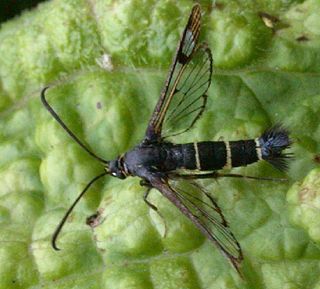
The Sesiidae or clearwing moths are a diurnal moth family in the order Lepidoptera known for their Batesian mimicry in both appearance and behaviour of various Hymenoptera.
Ebbe Schmidt Nielsen was a Danish entomologist influential in systematics and Lepidoptera research, and an early proponent of biodiversity informatics. The journal Invertebrate Systematics was established with significant contributions from Nielsen, and he assisted in the founding of the Global Biodiversity Information Facility (GBIF). Nielsen wrote several books, published over eighty scientific papers, and was highly regarded within the scientific community. Following his death, the GBIF organised the Ebbe Nielsen Prize in his memory, awarded annually to promising researchers in the field of biodiversity informatics. The moth Pollanisus nielseni is named after Nielsen.

Castniidae, or castniid moths, is a small family of moths with fewer than 200 species: The majority are Neotropical with some in Australia and a few in south-east Asia. These are medium-sized to very large moths, usually with drab, cryptically marked forewings and brightly coloured hindwings. They have clubbed antennae and are day flying, and are often mistaken for butterflies. Indeed, some previous classification systems placed this family within the butterflies or skippers. The Neotropical species are commonly known as giant butterfly-moths, the Australian and Asian species as sun moths. The larvae are internal feeders, often on roots of epiphytes or on monocotyledons.

The Arctiini are a tribe of tiger moths in the family Erebidae.

The Adelidae or fairy longhorn moths are a family of monotrysian moths in the lepidopteran infraorder Heteroneura. The family was first described by Charles Théophile Bruand d'Uzelle in 1851. Most species have at least partially metallic, patterned coloration and are diurnal, sometimes swarming around the tips of branches with an undulating flight. Others are crepuscular and have a drab coloration. Fairy longhorn moths have a wingspan of 4–28 millimeters, and males often have especially long antennae, 1–3 times as long as the forewing.
Cecidosidae is a family of primitive monotrysian moths in the order Lepidoptera which have a piercing ovipositor used for laying eggs in plant tissue in which they induce galls, or they mine in bark. Nine species occur in southern Africa, five species in South America and Xanadoses nielseni was recently described from New Zealand. Some minute parasitoid wasps are known.

Eupterotidae is a family of insects in the order Lepidoptera with more than 300 described species.

Brachodidae is a family of day-flying moths, commonly known as little bear moths, which contains about 135 species distributed around much of the world. The relationships and status of the presently included genera are not well understood.

Xanadoses is a monotypic moth genus in the family Cecidosidae. It contains a single species, Xanadoses nielseni, which is endemic to New Zealand. X. nielseni is also known by the common name Kamahi bark scribbler. The larval host of this species is Weinmannia racemosa.

Tisis is a genus of small moths in the family Lecithoceridae. The genus was erected by Francis Walker in 1864.
Pollanisus nielseni is a moth of the family Zygaenidae. It inhabits the Australian state of Western Australia, mostly coastal areas, and has brilliantly shiny forewings. The diurnal adults are most active on sunny days. Eggs are laid on the plant Hibbertia spicata, and females touch each egg after oviposition with a tuft of hair on their abdomen, which attaches protective spines. The larvae are brightly coloured and feed on H. spicata before pupation.
Postplatyptilia nielseni is a moth of the family Pterophoridae. It is known from Argentina.
Coleophora nielseni is a moth of the family Coleophoridae. It is found in southern Queensland, Australia.
Plesiozela is genus of moths in the family Incurvariidae. It was described by Ole Karsholt and Niels P. Kristensen in 2003 and initially placed in the family Heliozelidae.
Plesiozela nielseni is a moth of the Heliozelidae family. It was described by Ole Karsholt and Niels P. Kristensen in 2003. It is found in Argentina.
Palaephatus is a genus of moths in the family Palaephatidae.
Tisis nielseni is a moth in the family Lecithoceridae. It was described by Kyu-Tek Park in 2001. It is found in Thailand.
Eriogenes is a moth genus of the family Depressariidae.
Eriogenes mesogypsa is a moth in the family Depressariidae. It was described by Edward Meyrick in 1925. It is found in Papua New Guinea and Australia.
Eriogenes cossoides is a moth in the family Depressariidae. It was described by Arthur Gardiner Butler in 1882. It is found on the Moluccas, New Britain and Duke of York Island and in Queensland on mainland Australia.







